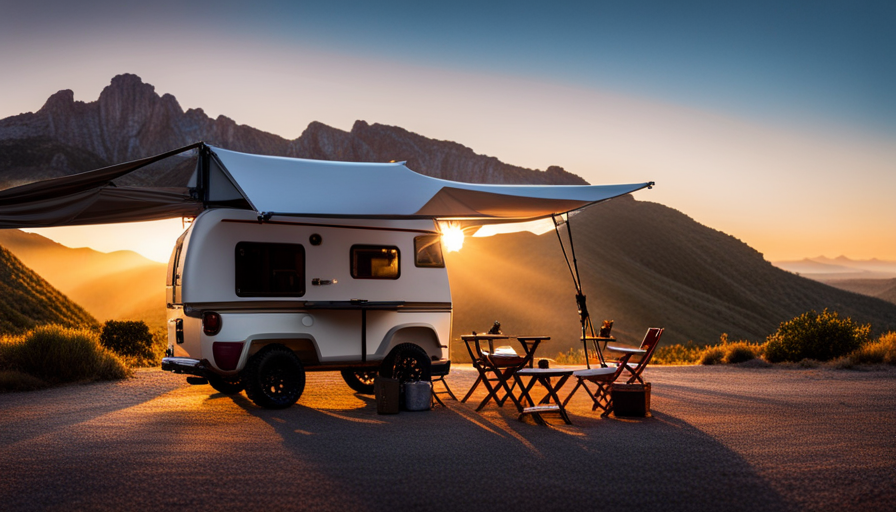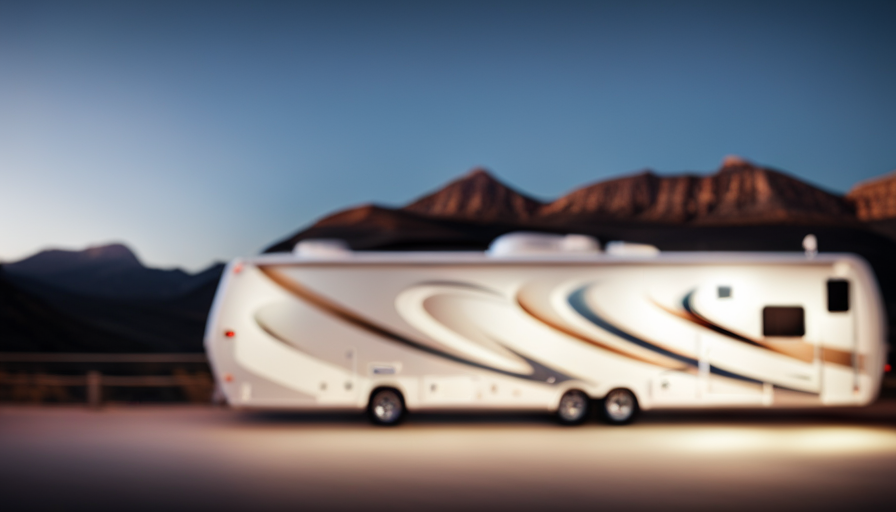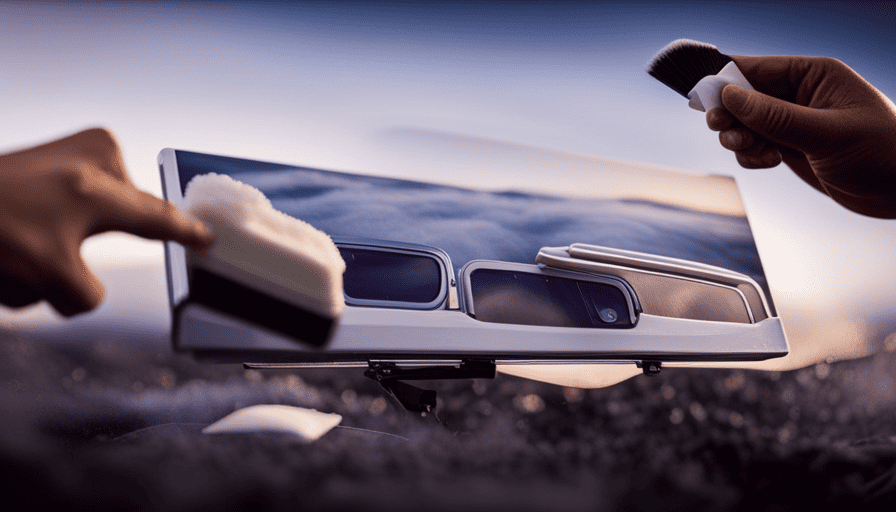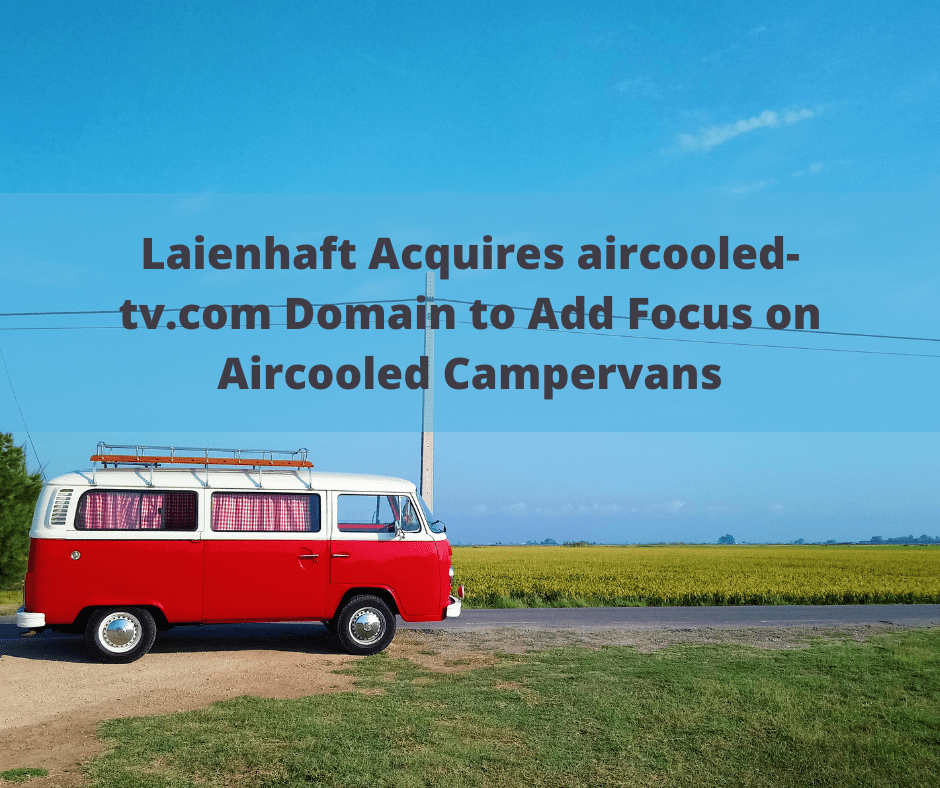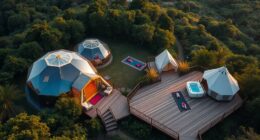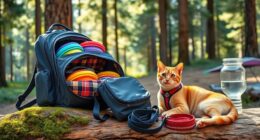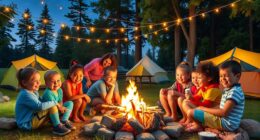Have you ever imagined embarking on a road trip and discovering the wonders of nature? Picture being able to journey to any destination your heart desires, while still having all the conveniences of home with you. That’s the beauty of a slide-in camper!
A slide in camper, also known as a truck camper or cabover camper, is a compact and versatile recreational vehicle that fits snugly into the bed of your pickup truck. It’s like having a portable home on wheels!
In this article, we will take you on a journey to discover the world of slide in campers. We’ll explore the benefits of owning one, the must-have features to look for, and how to choose the perfect camper for your needs. We’ll also delve into the maintenance and upkeep required, as well as the best campgrounds and parks to visit with your slide in camper.
Whether you’re a seasoned camper or new to the world of RVing, this article will provide you with valuable insights and tips to enhance your camping experience.
So, buckle up and let’s dive into the wonderful world of slide in campers!
Key Takeaways
- Slide-in campers are compact and versatile, fitting into the bed of a pickup truck and providing the comforts of home on the road.
- They offer the ability to access remote camping spots, are cost-effective and fuel-efficient, and can be detached from the truck.
- Slide-in campers have customizable exterior design options, clever storage solutions, and comfortable sleeping arrangements.
- Regular maintenance, thorough research, and proper storage organization are essential for a successful slide-in camper experience.
Overview of Slide In Campers
If you’re looking for a convenient and versatile camping option, you’ll love slide-in campers. They easily slide into the bed of your pickup truck, transforming it into a cozy and functional living space on wheels.
These compact campers are perfect for adventurers who want to explore different travel destinations without the hassle of towing a trailer or setting up a tent. With a slide-in camper, you can simply drive to your desired location, park, and start enjoying your outdoor adventure.
Not only are slide-in campers practical, but they also offer a cost-effective solution for camping enthusiasts. Compared to traditional RVs, slide-in campers are generally more affordable, making them a great choice for those who want to save money while still enjoying the comforts of home on their travels. Additionally, these campers are fuel-efficient, allowing you to save even more on transportation costs.
The benefits of a slide-in camper go beyond convenience and cost savings. In the next section, we’ll explore the numerous advantages these campers offer, from their compact size and easy maneuverability to their customizable features and ability to access remote camping spots.
Benefits of a Slide In Camper
You’ll be amazed by the convenience and versatility that comes with having a slide-in camper, making your travels a breeze.
One of the biggest benefits of a slide-in camper is its cost-effectiveness. Unlike traditional RVs, slide-in campers are generally more affordable, allowing you to save money for other adventures. Not only that, but slide-in campers also offer great fuel efficiency, saving you even more money in the long run.
Another advantage of slide-in campers is their versatility and adaptability. These campers are designed to fit onto the bed of a pickup truck, giving you the freedom to explore remote areas that may not be accessible to larger RVs. Whether you’re camping in the mountains, by the beach, or in a crowded campground, a slide-in camper can easily fit into any space, making it a perfect choice for all types of travel.
With their compact size, slide-in campers also offer the flexibility to detach from your truck, allowing you to use your vehicle for other purposes during your trip. This versatility is especially useful if you want to explore nearby attractions or run errands without having to bring your entire camper along.
Slide-in campers are cost-effective and offer incredible versatility and adaptability.
Now, let’s dive into the exciting features of a slide-in camper.
Features of a Slide In Camper
The compact yet functional design of a slide-in camper allows for seamless integration with your pickup truck, transforming it into a cozy and versatile mobile home on wheels. Whether you’re embarking on a weekend getaway or a cross-country adventure, the features of a slide-in camper are designed to enhance your camping experience.
Here are four key features of a slide-in camper:
-
Customizing Exterior Design: Slide-in campers offer various options for customizing the exterior design to match your personal style and preferences. From sleek and modern to rustic and rugged, you can choose a design that reflects your personality and stands out on the road.
-
Tips for Maximizing Space: Despite their compact size, slide-in campers are designed to maximize space efficiency. Clever storage solutions, foldable furniture, and innovative layouts make the most of every square inch. You’ll be amazed at how much functionality and comfort can be packed into such a small space.
-
Cozy Sleeping Areas: Slide-in campers typically feature comfortable sleeping arrangements, including a cozy bed that can accommodate two or more people. Some campers even have additional sleeping options, such as a convertible dinette or overhead bunk, allowing you to bring along family or friends.
-
Compact Kitchen and Bathroom: Slide-in campers often come equipped with a compact kitchenette, complete with a stove, sink, and refrigerator. Additionally, many models feature a small bathroom with a toilet and shower, providing a convenient and private space for freshening up on the go.
With these features, a slide-in camper offers a perfect blend of comfort, convenience, and mobility. When choosing the right slide-in camper for your needs, it’s important to consider factors such as size, weight, and amenities to ensure a seamless fit with your pickup truck.
Choosing the Right Slide In Camper
Embarking on a journey with your pickup truck is like setting sail on a grand adventure, and choosing the right slide-in camper is like finding the perfect compass to guide you along the way.
When it comes to selecting the ideal slide-in camper, there are a few factors to consider. First and foremost, think about your traveling essentials. Are you planning to go off-grid and need a camper with ample storage space for food, water, and supplies? Or maybe you prefer a more compact camper that’s easy to maneuver and park in crowded campgrounds.
Another crucial aspect to consider is your budget. Thankfully, there are budget-friendly options available in the market that offer all the necessary amenities without breaking the bank. These campers may not have all the bells and whistles, but they provide a comfortable and convenient space for your travels.
It’s important to do thorough research and read reviews to ensure you choose a camper that suits your specific needs and preferences. By finding the right slide-in camper, you’ll have a reliable and cozy home on wheels for your adventurous journeys.
As we move on to discussing the maintenance and upkeep of a slide-in camper, it’s important to understand how to take care of your investment and keep it running smoothly.
Maintenance and Upkeep of a Slide In Camper
When it comes to the maintenance and upkeep of a slide-in camper, there are a few key points to consider.
First, cleaning and storage tips are crucial for keeping your camper in top shape.
Regular inspections and repairs are also important to address any potential issues before they become major problems.
Finally, winterization and cold weather care are essential to protect your camper during the colder months.
By following these tips, you can ensure that your slide-in camper stays in great condition for years to come.
Cleaning and Storage Tips
Get ready to roll up your sleeves and learn some handy tips for keeping your slide-in camper clean and well-organized! Proper cleaning maintenance is essential to ensure that your camper stays in top condition.
Start by thoroughly cleaning the interior and exterior of your camper after each trip. Make sure to remove any debris, dust, or dirt from the surfaces, including the floors, countertops, and windows.
Additionally, pay attention to the storage organization inside your camper. Utilize bins, racks, and dividers to keep everything in its place and prevent clutter.
When it comes to storage, find a dry, secure location to keep your camper when it’s not in use. This will help protect it from the elements and potential damage.
As you finish up these cleaning and storage tasks, it’s important to transition into regular inspections and repairs to ensure the longevity of your slide-in camper.
Regular Inspections and Repairs
Make sure you keep an eye out for any signs of wear and tear, as well as potential water leaks, as you continue to inspect and repair your slide-in camper. Regular inspections are crucial to maintaining the longevity and functionality of your camper.
Here are a few things to consider during your inspections:
-
Inspecting Seals:
- Check the seals around windows, doors, and slide-outs for any cracks or gaps.
- Apply sealant if necessary to prevent water from seeping in.
-
Repairing Water Damage:
- Look for any signs of water damage, such as soft spots or discoloration on walls and ceilings.
- Address any water damage promptly to prevent further deterioration and mold growth.
By regularly inspecting seals and repairing water damage, you can ensure that your slide-in camper remains in excellent condition.
Now, let’s move on to the next section about winterization and cold weather care.
Winterization and Cold Weather Care
Preparing for the colder months is essential to protect your slide-in camper and ensure it stays in top condition during winter. Winterization tips are crucial to prevent any potential damage caused by freezing temperatures.
One of the most important aspects of winterizing your slide-in camper is preventing frozen pipes. To achieve this, make sure to drain all water tanks and lines thoroughly, and consider using antifreeze to protect the plumbing system.
Additionally, insulating your camper’s windows and doors can help keep the interior warm and cozy during cold weather. Taking these precautions will safeguard your camper from any potential issues and allow you to enjoy your winter adventures worry-free.
Now, let’s move on to some useful tips for traveling with a slide-in camper without compromising comfort and safety.
Tips for Traveling with a Slide In Camper
When you’re on the road with a slide-in camper, it’s like having a cozy home on wheels, allowing you to explore new places while still enjoying the comforts of home. Here are four tips for traveling with a slide-in camper:
-
Traveling with pets: One of the great things about having a slide-in camper is that it can accommodate your furry friends. Make sure to bring their favorite toys, bedding, and food to keep them comfortable during the trip. Also, remember to research pet-friendly campgrounds and parks along your route.
-
Cooking in a slide-in camper: With a fully equipped kitchenette, cooking in a slide-in camper is a breeze. You can prepare delicious meals on the go, saving money on eating out. Don’t forget to stock up on ingredients, utensils, and cookware before hitting the road.
-
Storage and organization: To make the most of the limited space in a slide-in camper, it’s essential to stay organized. Use storage containers, hooks, and shelves to keep your belongings tidy and easily accessible. This will help create a more comfortable and efficient living environment.
-
Safety and maintenance: Before embarking on your journey, ensure that your slide-in camper is in good condition. Check the tires, brakes, and lights, and make sure all systems are functioning properly. Additionally, carry emergency supplies like a first aid kit, fire extinguisher, and roadside assistance contact information.
When traveling with a slide-in camper, it’s important to know about suitable campgrounds and parks where you can park and enjoy your stay.
Campgrounds and Parks for Slide In Campers
When it comes to finding campgrounds and parks for slide-in campers, we’re in luck! National Parks and Forests offer some of the most breathtaking and scenic camping options, allowing us to immerse ourselves in nature’s beauty.
RV parks and campgrounds are another great option, providing amenities and facilities that make camping comfortable and convenient.
And for those seeking a more off-grid and adventurous experience, there are plenty of boondocking options available, where we can camp in remote and secluded areas, away from the crowds.
National Parks and Forests
Imagine exploring the breathtaking landscapes of National Parks and Forests in a slide-in camper, where you can immerse yourself in nature and wake up to stunning views every morning. It’s an experience like no other, allowing you to truly connect with the great outdoors.
Here are three reasons why national parks are perfect for slide-in campers:
-
Unparalleled beauty: From the towering peaks of Yosemite National Park to the majestic canyons of Grand Canyon National Park, these natural wonders offer unparalleled beauty that will leave you in awe.
-
Access to outdoor activities: National parks provide a plethora of outdoor activities such as hiking, fishing, and wildlife spotting. With your slide-in camper, you have the convenience of bringing all your camping gear, making it easy to explore and enjoy these activities.
-
Peace and tranquility: Camping in national parks allows you to escape the hustle and bustle of everyday life and find peace and tranquility. Waking up to the sound of birds chirping and the fresh scent of pine trees is a rejuvenating experience.
As you continue your adventure, let’s dive into the next section about RV parks and campgrounds, where you can find even more opportunities for outdoor exploration.
RV Parks and Campgrounds
Get ready to discover the convenience and camaraderie of RV parks and campgrounds, where you’ll find endless opportunities for outdoor exploration and relaxation. RV parks offer a range of amenities to enhance your camping experience. Many parks provide full hookups for water, electricity, and sewer, allowing you to enjoy all the comforts of home while surrounded by nature.
Other amenities may include Wi-Fi, laundry facilities, swimming pools, and playgrounds for the kids. It’s important to be mindful of camping etiquette while staying at these parks, such as respecting quiet hours, keeping your campsite clean, and being considerate of your fellow campers. With these guidelines in mind, RV parks provide a wonderful setting for making lasting memories with family and friends.
As you delve into the world of camping, you’ll also discover off-grid and boondocking options that offer a different kind of adventure.
Off-Grid and Boondocking Options
Exploring off-grid and boondocking options allows us to disconnect from the hustle and bustle of everyday life and immerse ourselves in a truly authentic outdoor experience. When it comes to off-grid power options, there are several choices available to ensure that you have electricity even when you are far away from civilization.
These options include solar panels, portable generators, lithium batteries, and inverters.
Additionally, slide-in campers with off-road capabilities provide the freedom to venture into remote areas and explore rugged terrains without worrying about damaging your camper. These campers are built with reinforced frames, heavy-duty suspensions, and off-road tires to handle rough roads and uneven terrain.
As we delve into the next section about DIY modifications and upgrades for slide-in campers, we will discover how to further enhance our camping experience.
DIY Modifications and Upgrades for Slide In Campers
When it comes to slide-in campers, there are endless possibilities for customizing the interior layout to fit our specific needs and preferences.
From rearranging furniture to adding extra storage space, the options are limitless.
Additionally, installing solar panels or generators can provide us with the freedom to go off the grid and have a self-sufficient camping experience.
Lastly, adding storage and convenience features, such as overhead cabinets and built-in appliances, can make our camping trips more enjoyable and efficient.
With these modifications and upgrades, we can truly make our slide-in camper a home away from home.
Customizing Interior Layout
Imagine stepping inside your slide-in camper and being greeted by a cozy interior layout that’s uniquely tailored to your preferences, making you feel right at home. Customizing the interior layout of your slide-in camper is an exciting opportunity to maximize space and create a functional living area that suits your needs.
To achieve this, consider incorporating clever storage solutions such as built-in cabinets and drawers, collapsible furniture, and overhead compartments. These additions will help you make the most of every inch of available space, ensuring that you have enough room for all your essentials.
Additionally, you can customize the layout by adding comfortable seating areas, a compact kitchenette, and a cozy sleeping area.
By customizing the interior layout of your slide-in camper, you can transform it into a personalized oasis on wheels. Once you’ve created the perfect living space, you can move on to the next step of installing solar panels or generators to ensure a self-sufficient and sustainable camping experience.
Installing Solar Panels or Generators
To create a truly self-sufficient and sustainable oasis on wheels, you’ll need to consider installing solar panels or generators to power your customized interior layout.
Solar panel installation is a popular choice for those looking to harness the power of the sun. By converting sunlight into electricity, solar panels can provide a reliable and eco-friendly source of energy for your camper. This allows you to run appliances, charge devices, and light up your space without relying on traditional power sources.
Generator installation is another option to consider, especially for those who require a higher power output or need a backup power source. Generators can run on various fuels such as gasoline, propane, or diesel, providing you with flexibility in terms of fuel availability.
With solar panels or generators, you can create a sustainable and independent power system, ensuring that your slide-in camper is always ready for your next adventure.
Now, let’s explore adding storage and convenience features to optimize your space.
Adding Storage and Convenience Features
Adding storage and convenience features to your mobile oasis can greatly enhance your overall camping experience. When it comes to slide-in campers, maximizing storage solutions and utilizing camping hacks is essential.
One popular storage hack is utilizing under-bed storage compartments to keep your gear organized and easily accessible. Installing overhead cabinets can provide additional space for kitchen essentials and camping gear.
Another convenient feature to consider is adding a slide-out pantry, which allows for easy access to food items and saves valuable space. Additionally, installing hooks and racks on the walls can provide a convenient place to hang coats, towels, and other items.
By incorporating these storage solutions and camping hacks, you can optimize the space in your slide-in camper and make your camping adventures more enjoyable.
Now, let’s delve into the stories and experiences of slide-in camper owners.
Stories and Experiences of Slide In Camper Owners
Hearing the stories and experiences of slide-in camper owners will make you feel a deep sense of wanderlust and adventure. There’s something magical about hitting the open road with all your belongings right behind you, ready for wherever the journey takes you.
Slide-in campers offer a unique and convenient way to travel, and those who own them have plenty of tales to share. Here are some stories and experiences that slide-in camper owners have shared:
-
One owner recounted their unforgettable cross-country road trip, where they explored national parks and camped under the starry sky every night.
-
Another owner shared how their slide-in camper allowed them to take spontaneous weekend trips, providing the freedom to escape from the daily grind whenever they desired.
-
A couple shared their favorite travel tips, emphasizing the importance of slide-in camper maintenance to ensure a smooth and trouble-free journey.
-
One family described how their slide-in camper allowed them to create lasting memories with their children, as they explored new places and bonded over campfire stories.
These stories and experiences highlight the joy and versatility that come with owning a slide-in camper. They inspire others to embark on their own adventures and discover the wonders of the open road.
As we conclude our exploration of slide-in campers, let’s reflect on the incredible experiences that await those who choose this nomadic lifestyle.
Conclusion and Final Thoughts
As we wrap up our exploration of slide-in campers and the stories and experiences of their owners, we can’t help but reflect on the incredible adventures that these compact and versatile vehicles have facilitated. From remote camping spots nestled in the heart of nature to bustling RV parks filled with fellow travelers, slide-in campers have opened up a world of possibilities for those seeking a nomadic lifestyle.
Now, as we come to the conclusion of our discussion, we want to leave you with some valuable traveling tips and recommendations for the best destinations to explore with a slide-in camper. First and foremost, always plan ahead and research potential campsites to ensure they can accommodate your camper’s size and have the necessary amenities. Additionally, don’t be afraid to venture off the beaten path and discover hidden gems off the tourist radar.
Some of the best destinations for slide-in campers include national parks like Yosemite, Glacier, and Zion, where stunning landscapes and outdoor activities abound.
Whether you’re a seasoned slide-in camper owner or considering embarking on your first adventure, we hope our discussions have provided you with valuable insights and inspiration. So go out there, hit the road, and create memories that will last a lifetime. Happy travels!
Frequently Asked Questions
Are slide in campers suitable for all types of trucks?
Slide in campers can be suitable for a wide range of trucks, but it’s important to consider modifications. Depending on the truck’s bed length, weight capacity, and suspension system, some adjustments may be necessary to ensure a proper fit and safe operation.
However, slide in campers offer numerous advantages, such as versatility, easy installation, and the ability to detach from the truck. On the downside, they can be more expensive and may limit the truck’s payload capacity.
What are the weight restrictions for slide in campers?
When it comes to slide-in campers, weight restrictions are crucial. These limits ensure that the camper is compatible with different types of trucks.
Think of it like a dance partner – you want someone who can move with grace, not someone who will buckle under pressure.
It’s important to know the weight limits of your truck so you can choose a slide-in camper that won’t strain its capabilities.
Can slide in campers be used in all weather conditions?
Slide in campers can be used in all weather conditions, but their performance may vary. The insulation in slide in campers helps maintain a comfortable temperature inside, making them suitable for extreme weather. However, there are pros and cons to consider.
In extreme cold, the insulation can keep you warm, but condensation may be an issue. In extreme heat, the insulation helps keep the interior cool, but ventilation becomes crucial.
Overall, slide in campers offer versatility but require proper preparation and management in extreme weather.
Are slide in campers easy to set up and take down?
Setting up and taking down slide-in campers can be a breeze! We’ve got the inside scoop on all the pros and cons.
When it comes to setting up, these campers are a piece of cake. Just slide them into the bed of your truck and you’re good to go.
Taking them down is just as easy – simply slide them out and you’re ready to hit the road.
With their convenience and simplicity, slide-in campers are a camper’s dream come true.
Can slide in campers be customized to fit specific needs or preferences?
Yes, slide in campers can definitely be customized to fit specific needs and preferences. There are various customization options available, allowing you to personalize the interior design according to your taste and requirements. From choosing different materials and colors to adding specific features like extra storage or upgraded appliances, the possibilities are endless.
This level of customization ensures that your slide in camper perfectly reflects your style and enhances your camping experience.
Conclusion
In conclusion, slide in campers are a fantastic option for those who love the great outdoors and want a comfortable and convenient way to travel and camp. With their versatile design and features, slide in campers offer the perfect combination of mobility and home-like comfort.
Whether you’re exploring national parks or embarking on a cross-country road trip, a slide in camper can enhance your camping experience. Take for example, Sarah and Mike, a couple who used their slide in camper to travel across the country, creating unforgettable memories and discovering hidden gems along the way.
The possibilities are endless with a slide in camper, so why not start your own adventure today?

